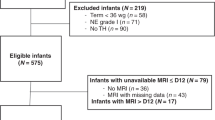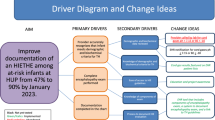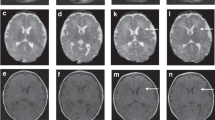Abstract
As care of the most vulnerable infants in the neonatal intensive care unit (NICU) evolves, improved and real-time understanding of brain health becomes key. The availability of an in-NICU magnetic resonance imaging (MRI) scanner provides unique options to bedside care providers and researchers. We present our perspective on the 1-Tesla MRI unit in our NICU and its utilities and applications both in the clinical and research fields. We also discuss our experience with early and serial MRI in a cohort of infants with hypoxic-ischemic encephalopathy while undergoing therapeutic hypothermia, using a compatible cooling blanket and monitoring apparatus with special insight into the planning and organization between providers, and parental perspectives around early, detailed imaging.

Similar content being viewed by others
References
Shankaran S, Laptook AR, Pappas A, McDonald ScottA, Das A, Tyson JE, et al. Effect of depth and duration of cooling on death or disability at age 18 months among neonates with hypoxic-ischemic encephalopathy: a randomized clinical trial. JAMA. 2017;318:57.
Johnson S, Marlow N. Early and long-term outcome of infants born extremely preterm. Arch Dis Child. 2017;102:97–102.
Inder TE, de Vries LS, Ferriero DM, Grant PE, Ment LR, Miller SP, et al. Neuroimaging of the preterm brain: review and recommendations. J Pediatr. 2021;237:276–287.e4.
Thiim KR, Singh E, Mukundan S, Grant PE, Yang E, El-Dib M, et al. Clinical experience with an in-NICU magnetic resonance imaging system. J Perinatol. 2022;42:873–9.
Singh E, Thiim KR, Rostas S, Cadogan J, El-Dib M, Inder TE. Improving access to magnetic resonance imaging for the newborn. J Neonatal Nurs. 2023;29:199–202.
Berson ER, Mozayan A, Peterec S, Taylor SN, Bamford NS, Ment LR, et al. A 1-Tesla MRI system for dedicated brain imaging in the neonatal intensive care unit. Front Neurosci. 2023;17:1132173.
Bin-Nun A, Kasirer Y, Abu-Ata N, Rosenbaum D, Cytter-Kuint R, Hammerman C, et al. Detection of global brain injury using point-of-care neonatal MRI scanner. Neuropediatrics. 2023;54:253–9.
Roychaudhuri S, Côté-Corriveau G, Erdei C, Inder TE. White matter injury on early-versus-term-equivalent age brain MRI in infants born preterm. Am J Neuroradiol. 2024;45:224–8.
Edwards AD, Redshaw ME, Kennea N, Rivero-Arias O, Gonzales-Cinca N, Nongena P, et al. Effect of MRI on preterm infants and their families: a randomised trial with nested diagnostic and economic evaluation. Arch Dis Child Fetal Neonatal Ed. 2018;103:F15–21.
Gano D, Chau V, Poskitt KJ, Hill A, Roland E, Brant R, et al. Evolution of pattern of injury and quantitative MRI on days 1 and 3 in term newborns with hypoxic–ischemic encephalopathy. Pediatr Res. 2013;74:82–7.
Shetty AN, Lucke AM, Liu P, Sanz Cortes M, Hagan JL, Chu ZD, et al. Cerebral oxygen metabolism during and after therapeutic hypothermia in neonatal hypoxic–ischemic encephalopathy: a feasibility study using magnetic resonance imaging. Pediatr Radiol. 2019;49:224–33.
Wintermark P, Labrecque M, Warfield SK, DeHart S, Hansen A. Can induced hypothermia be assured during brain MRI in neonates with hypoxic-ischemic encephalopathy? Pediatr Radiol. 2010;40:1950–4.
Sagaser A, Pilon B, Goeller A, Lemmon M, Craig AK. Parent Experience of Hypoxic-Ischemic Encephalopathy and Hypothermia: A Call for Trauma Informed Care. Am J Perinatol. 2024;41:586–93.
Wu YW, Monsell SE, Glass HC, Wisnowski JL, Mathur AM, McKinstry RC, et al. How well does neonatal neuroimaging correlate with neurodevelopmental outcomes in infants with hypoxic-ischemic encephalopathy? Pediatr Res. 2023. https://www.nature.com/articles/s41390-023-02510-8.
Negro S, Benders MJNL, Tataranno ML, Coviello C, de Vries LS, van Bel F, et al. Early prediction of hypoxic-ischemic brain injury by a new panel of biomarkers in a population of term newborns. Oxid Med Cell Longev. 2018;2018:1–10.
Erdei C, Cherkerzian S, Pineda R, Inder TE. Serial neuroimaging of brain growth and development in very preterm infants receiving tailored neuropromotive support in the NICU. Protocol for a prospective cohort study. Front Pediatr. 2023;11:1203579.
Garvey AA, El-Shibiny H, Yang E, Inder TE, El-Dib M. Differences between early and late MRI in infants with neonatal encephalopathy following therapeutic hypothermia. Pediatr Res. 2023;94:1011–7.
Thiim KR, Garvey AA, Singh E, Walsh B, Inder TE, El-Dib M. Brain injury in infants evaluated for, but not treated with, therapeutic hypothermia. J Pediatr. 2023;253:304–9.
Acknowledgements
We thank our research nurses Elizabeth Singh, Yvonne Sheldon, Tina Steele, and Deborah Cuddyer for their involvement and contribution throughout the work. We are grateful to all the parents who gave us their time, consideration and trust.
Author information
Authors and Affiliations
Contributions
SR and YE participated in research data acquisition, drafted the initial manuscript, and reviewed and revised the manuscript. MED designed the study, assisted with data acquisition, and reviewed and revised the manuscript. TEI conceptualized and designed the studies, helped to draft the initial manuscript, and reviewed and revised the manuscript. All authors approved the final manuscript as submitted and agree to be accountable for all aspects of the work.
Corresponding author
Ethics declarations
Competing interests
Dr. Terrie E. Inder is a member of the Scientific Advisory Board for Aspect Imaging.
Additional information
Publisher’s note Springer Nature remains neutral with regard to jurisdictional claims in published maps and institutional affiliations.
Rights and permissions
Springer Nature or its licensor (e.g. a society or other partner) holds exclusive rights to this article under a publishing agreement with the author(s) or other rightsholder(s); author self-archiving of the accepted manuscript version of this article is solely governed by the terms of such publishing agreement and applicable law.
About this article
Cite this article
Roychaudhuri, S., Ersen, Y., El-Dib, M. et al. Point of care magnetic resonance neonatal neuroimaging applications and early imaging in infants under active therapeutic hypothermia: a perspective. J Perinatol (2024). https://doi.org/10.1038/s41372-024-02033-y
Received:
Revised:
Accepted:
Published:
DOI: https://doi.org/10.1038/s41372-024-02033-y
- Springer Nature America, Inc.




